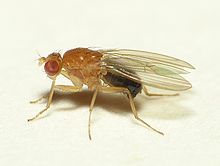| Drosophilidae | |
|---|---|

| |
| Lordiphosa andalusiaca | |
| Scientific classification | |
| Domain: | Eukaryota |
| Kingdom: | Animalia |
| Phylum: | Arthropoda |
| Class: | Insecta |
| Order: | Diptera |
| Superfamily: | Ephydroidea |
| Family: | Drosophilidae Rondani, 1856 |
| Subfamily | |
The Drosophilidae are a diverse, cosmopolitan family of flies, which includes species called fruit flies, although they are more accurately referred to as vinegar or pomace flies.[1] Another distantly related family of flies, Tephritidae, are true fruit flies because they are frugivorous, and include apple maggot flies and many pests. The best known species of the Drosophilidae is Drosophila melanogaster, within the genus Drosophila, also called the "fruit fly." Drosophila melanogaster is used extensively for studies concerning genetics, development, physiology, ecology and behaviour. Many fundamental biological mechanisms were discovered first in D. melanogaster.[2] The fruit fly is mostly composed of post-mitotic cells, has a very short lifespan, and shows gradual aging. As in other species, temperature influences the life history of the animal. Several genes have been identified that can be manipulated to extend the lifespan of these insects. Additionally, Drosophila subobscura, also within the genus Drosophila, has been reputed as a model organism for evolutionary-biological studies,[3] along with D. sechellia for the evolution of host specialization on the toxic noni fruit[4] and Scaptomyza flava for the evolution of herbivory and specialist on toxic mustard leaves.[5]
- ^ Markow, Ann Therese (2006). Drosophila : a guide to species identification and use. Elsevier. ISBN 0-08-045409-7. OCLC 74908130.
- ^ Mohr, Stephanie Elizabeth (2018). First in fly: Drosophila research and biological discovery. Harvard University Press. ISBN 978-0-674-97101-1. OCLC 1034915732.
- ^ Krimbas, C.B. & Loukas,M.(1980) Inversion Polymorphism of Drosophila subobscura Evol.Biol.12,163-234.
- ^ Jones, Corbin D., "The genetics of adaptation in Drosophila sechellia", Georgia Genetics Review III, Berlin/Heidelberg: Springer-Verlag, pp. 137–145, retrieved 2021-12-18
- ^ Whiteman, Noah K.; Groen, Simon C.; Chevasco, Daniela; Bear, Ashley; Beckwith, Noor; Gregory, T. Ryan; Denoux, Carine; Mammarella, Nicole; Ausubel, Frederick M.; Pierce, Naomi E. (2010-11-13). "Mining the plant-herbivore interface with a leafmining Drosophila of Arabidopsis". Molecular Ecology. 20 (5): 995–1014. doi:10.1111/j.1365-294x.2010.04901.x. ISSN 0962-1083. PMC 3062943.